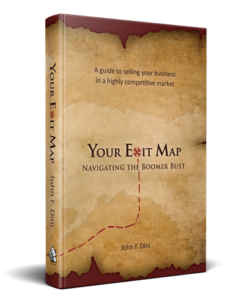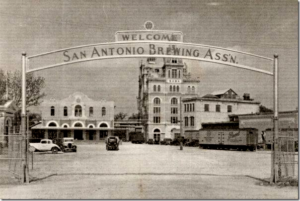Ambiguity kills value. That was a key point in a white paper from Orange Kiwi that I read over the holidays. Taken from the PhD thesis of Dr. Allie Taylor, the paper describes the psychological profile of entrepreneurs, and their historical reluctance to begin an exit planning process.
According to Dr. Taylor, entrepreneurs have five major behavioral traits; Risk Taking, Innovativeness, Need for Achievement, tolerance for Ambiguity and a locus for Control. This follows closely my description of the mind of an entrepreneur in Hunting in a Farmer’s World. In that book I discuss the traits of tenacious problem solving and the ability to navigate in the fog.
Ambiguity and Dopamine
That ability to choose a path where others don’t see a way forward is key to a business owner’s ability to stomach risk. What Dr. Taylor points out, however, is that some owners fall in love with their own tolerance for ambiguity. As Simon Sinek points out in Leaders Eat Last (and I also discuss in Hunting,) problem solving provides an owner with a little shot of Dopamine dozens, or even scores of times daily.
Dopamine is the same neurotransmitter that drives substance abuse. In very real terms, an owner’s need for regular dopamine titillations can make decision making addictive. Anticipating a life without the business can subconsciously create a fear of life without the business.
That’s why owners are reluctant to discuss exit planning. Despite the obvious wisdom of controlling the most important financial event of a lifetime, the personal void that lies beyond ownership is scary. As with many other potentially unpleasant things, from going to the dentist to funeral prearrangements, it’s easy to deal with it…later.
Ambiguity Kills Value
The problem with embracing ambiguity too much is that it can damage your business. Management by firefighting is costly. As Abraham Lincoln said, “If I had eight hours to cut down a tree, I’d spend seven of those sharpening my saw,” Fixing problems almost always costs more than preventing them. Dealing with distractions reduces the time you have available for selling, creating or teaching.
Avoiding the uncomfortable task of exit planning leaves you much more likely to deal with it in response to one of the Dismal D’s. (Death, Disease, Disability, Divorce, Declining sales, Dissention among owners, Debt, Distraction, Disaster or Disinterest.) That’s when the value of your most important asset, a thriving business, starts to plummet.
We all like a bit of ambiguity. Our decision making abilities are what makes us successful owners. Exit planning should be a process of gathering information about your possible decisions, not a ticking clock controlling your future.
Embracing Your Options
 Whether you plan to eventually sell your business to a third party, pass it on to family or create a transfer to employees, you still want to assess your financial performance compared to industry standards. Your management team needs to be able to run the company without you. Your processes should be well documented. Most importantly, you should be thinking about what you will do when those hits of decision-making dopamine stop coming.
Whether you plan to eventually sell your business to a third party, pass it on to family or create a transfer to employees, you still want to assess your financial performance compared to industry standards. Your management team needs to be able to run the company without you. Your processes should be well documented. Most importantly, you should be thinking about what you will do when those hits of decision-making dopamine stop coming.
Once you have the components in place, you can control the timing, proceeds and method of your transition. Until then, you are just waiting for ambiguity to bite you in the butt.
How prepared are you? Take the ExitMap® preparedness Assessment at www.YourExitMap.com
 That approach helped the company grow with a balanced customer base. BVA has a presence in food testing laboratories, water and wastewater plants and the Texas oil fields, rather than the typical dominance of doctors and hospitals for their type of business.
That approach helped the company grow with a balanced customer base. BVA has a presence in food testing laboratories, water and wastewater plants and the Texas oil fields, rather than the typical dominance of doctors and hospitals for their type of business.
 Located next to the major north-south traffic artery from the airport to downtown, The brewery has now been transformed into what is likely the best industrial redevelopment in the nation.
Located next to the major north-south traffic artery from the airport to downtown, The brewery has now been transformed into what is likely the best industrial redevelopment in the nation. brewery equipment, largely heavy iron fixtures from the early 20th century, was stripped out, inventoried and stored. Every project in the redevelopment integrates the equipment as a centerpiece, lending a cool steampunk feel to the restaurants and public areas.
brewery equipment, largely heavy iron fixtures from the early 20th century, was stripped out, inventoried and stored. Every project in the redevelopment integrates the equipment as a centerpiece, lending a cool steampunk feel to the restaurants and public areas. On the “inland” side along Broadway and across the river, other developers have put up new apartments whose chief attraction is “within walking distance of The Pearl.” Another developer is planning a similar complex (18 acres) directly across the street.
On the “inland” side along Broadway and across the river, other developers have put up new apartments whose chief attraction is “within walking distance of The Pearl.” Another developer is planning a similar complex (18 acres) directly across the street. The M&A world abounds with horror stories of financial buyers who stripped the employee benefits from a company and drove off its key personnel. Others pulled their capital as soon as they had control (to leverage it in another deal) and left the business staggering under the debt replacing it. Still more inserted a Hired Gun executive from another industry whose inexperience quickly ran the business on the rocks.
The M&A world abounds with horror stories of financial buyers who stripped the employee benefits from a company and drove off its key personnel. Others pulled their capital as soon as they had control (to leverage it in another deal) and left the business staggering under the debt replacing it. Still more inserted a Hired Gun executive from another industry whose inexperience quickly ran the business on the rocks. Tax complexity makes handling almost any transaction without professional advice foolhardy, but are we really supposed to just draw a line through 16 weeks, or 1/3 of the annual business cycle?
Tax complexity makes handling almost any transaction without professional advice foolhardy, but are we really supposed to just draw a line through 16 weeks, or 1/3 of the annual business cycle?